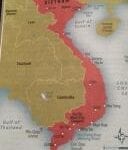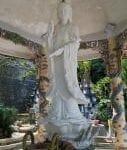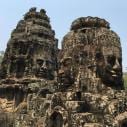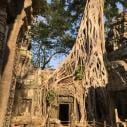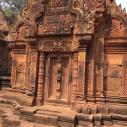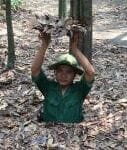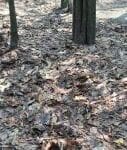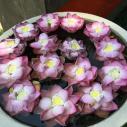Written by Marsha Seidelman, M.D.
March 23, 2016

We just returned from a two week whirlwind tour through Vietnam, with one stop in Siem Reap, Cambodia. Since this was my first time traveling in Asia, there was a tremendous amount to take in, including the the physical beauty, the history of the region, the culture, the food, the unique traffic patterns … The photos below will give you a glimpse at it, but really don’t give the big picture.
We were taken by the sheer beauty in different parts of the countries – some natural, some manmade. In the north, the formation of limestone karst islands in the Gulf of Tonkin’s Halong Bay, which means ‘where the dragon descends into the sea’ is remarkable. It’s as if a dragon’s flailing tail carved out the mountains. Surprise Cave on one of these islands is a huge cave with 3 vast chambers with nature’s art decorating the walls. The many pagodas, The Museum of Fine Arts in Hanoi, the beach and Imperial Palaces in Hue, and the Angkor Temples in Cambodia were all remarkable and each told part of the area’s history. Halong Bay and Angkor Wat have both been declared World Heritage sites.
At first, learning about Southeast Asia history was overwhelming, but as we spent time and heard the information from different sources, absorbed the personal stories, things started to fall into place. In the U.S., we take for granted that we don’t have empires on all sides trying to take us over. In Vietnam and Cambodia, as different groups dominated, they left their mark on the local culture, and this varies even between the northern and southern parts of Vietnam.
China ruled over Vietnam for a thousand years until 938 AD. Over the centuries, the Khmer, Mongols, Chams, and French have ruled. The spoken language of Vietnam resembles Chinese, but the written language was changed to our familiar Latin letters in the 1600’s and took hold in the 1800’s when French missionaries came to spread Catholicism. So, on the surface, it appears as if we should be able to read and speak Vietnamese, but there is a complex series of markings to create 6 different intonations, each totally changing the meaning of the words. For instance, the simple word ‘ma’ with different markings could mean a ghost, mom, to be, a young rice plant, a grave or a horse. Moreso than with any other travel, I was reluctant to try to say much for fear that I’d be expressing something totally different than what I meant. We were able to say ‘thank you’ fairly well, but not much more.
Exploring 20th century history in Vietnam and Cambodia was difficult for us, in stark contrast to the treasures of rich empires and beautiful monuments that we saw glorifying other parts of their history. In the north, the ‘Hanoi Hilton’ was a prison initially built by the French to house Vietnamese prisoners. At the time of the Vietnamese War, it was used to torture American pilots, including Senator John McCain. We were told that the prisoners were treated well (not true) so that world opinion would be favorable to the North Vietnam Army (NVA) and Viet Cong (VC). At nearby West Lake, there is a small statue of a prisoner secured with his arms up behind his back. The signage other than John McCain’s name was all in Vietnamese, so I can’t say what it said. Our guide told us it was to ‘honor’ him when he became a politician – doubtful.
In the south, near Saigon, now known as Ho Chi Minh City, (the names seem to be used interchangeably) we went to the CuChi tunnels, an underground city which the NVA and VC used to protect themselves and launch surprise attacks on the U.S. and South Vietnamese Army (SVA). The construction of these is remarkable, with hospital bays, kitchens, sleeping quarters and extended exhaust pipes so the location of the living areas remained secret. The openings to the outdoors were minuscule and very well camouflaged with dirt and branches. They were also booby trapped with various spikes to kill anyone who tried to make his way in. The heat in the tunnels and the jungle – and we weren’t even there in the hottest season – made us sympathetic to how difficult our troops had it.
There’s a War Remnants Museum in Saigon, which shows the napalm and Agent Orange effects in gory detail. These agents were used to exfoliate the forest along the Ho Chi Minh trail. This trail, over 1000 miles long, was used extensively to move troops, weapons, and food from North to South Vietnam. Although we are at fault for using these toxins, for someone without other knowledge of the war, the museum displays make it appear that the U.S. was the aggressor, out of the blue, in an otherwise peaceful area. As in many other cases, history is written by the victor.
In 1975, the same year that Vietnam was unified under the Communist Party, Pol Pot came to power in Cambodia. His Khmer Rouge party was a China-backed Communist group. They went on to kill one quarter of the population, focusing on journalists, teachers and other educated people who were a threat to them. All but 50 of the 4000 doctors in the country were killed or fled to Europe. Millions of land mines were placed, and as a result, many people can be seen on the street today with missing limbs. Support for the wounded comes from non-governmental organizations and other donations, not from the government. By now, most of the mines have been removed although some remain in the jungle. There was an interesting piece on NPR last year about using special African rats to search for these plastic, difficult to detect mines, by the scent of their explosives.
By chance, we were staying near the Angkor Hospital for Children in Siem Reap and learned of this fantastic life-saving project started by Japanese photographer Kenro Azu when he visited Cambodia in 1993 to photograph the Angkor Temples. He was deeply touched by the resilient children he met and upset with the poor quality of health care. He founded a non-profit called Friends Without a Border, and helped to open this hospital in 1999, which now takes care of many of the poor, covering landmine injuries, general care and even heart surgery by medical volunteer groups. In addition they train medical staff for other facilities, overall significantly improving health care in Cambodia.
Although all of Vietnam has been unified since 1975 as the Socialist Republic of Vietnam, view of Communist rule seemed more favorable in the north than the south. Citizens are well aware that money talks, just as in a capitalist society, although it’s not criticized as publicly there. Cambodia is a democracy; money talks there as well. In both countries, the majority of the population is poor and it is a difficult life, with no safety net from the government.
To advance in the government, one must be a member of the Communist Party, which includes paying dues and participating in party discussions. Since allegiance to anything but the Party is frowned upon, practicing a religion is counted against you, as was having more than 2 children during the time of population control. Confucianism, a philosophy not a religion, is favored. Respect to the Leader, parents, teachers and ‘friends’ is of primary importance. In Vietnam, the main religion is actually ancestor worship, which is especially respectful of the deceased. Only 15% are Buddhists and 8% Christian. This is in contrast to Cambodia, a democracy, where over 90% are Buddhists. The Museum of Cham Sculpture in Vietnam has hundreds of beautiful, well-preserved artifacts from the 5th – 15th centuries when Hinduism was practiced through Indian presence. These were discovered only in the 20th century (photos).
We were told in the north that there is no homelessness or unemployment. People who appear to have no homes, “all have families to go home to.” They have jobs, in that they can sell lottery tickets or cigarettes on the street. The statistics come from the government. We seemed to get more of the party line in talking to people in the north, and more cynicism and openness in the south.
As we went further south, we were told of an abundance of foreign money being invested in roads, bridges and apartment buildings. Poor people in rundown homes were moved away from the main roads and provided housing in apartment buildings. The appearance as you drive through has evidently been totally transformed over the past decade or two.
The majority of the population is involved with farming, with rice being the main crop. It is difficult to make a decent living with this, especially in the north, where there are only two growing seasons per year, versus three or four in the south. This is literally back-breaking work (photo).
In the Mekong Delta in the south, we visited Vinh Long, where we saw family production of rice and coconut products, snake wine and clay pots (photos). At the last one, men were moving 100-pound bags of cement from a barge to the factory – literally running back and forth with these bags on their heads. They were paid 25 US dollars a day. There is no provision for disability, either naturally-occurring or due to difficult work like this.
Other families lived on small boats in the floating markets, which served as their home and store. Farmers are the wholesalers. They deliver their goods to the markets by boat, and the residents in the Delta region come to shop for their daily needs. There were filling stations and boat-servicing stations all along the way (photos).
One last thought on everyday life, more aimed at Vietnam than Cambodia – don’t EVER think of renting a car there. They do drive on the right side of the road – so what could be so difficult? There are millions of motorized scooters – literally – and very few traffic lights. Although the scooters are supposed to follow traffic laws, they do not. So cars following green lights through major intersections are dodging hundreds of scooters going across that same intersection. As pedestrians, we were told to make eye contact with motorists and carefully weave through lanes of traffic to cross the street. A popular T-shirt shows a traffic light, saying “Green means go, yellow means go, red means I still go”. It’s truly a sight, one that I could not adequately capture with a photo.
Overall, we were plunged into history in an area of the world that was previously unfamiliar to us. It was a very rich experience, one that has left me thinking more about the unfairness in the world and all the lives lost unnecessarily due to war. To look into one aspect of how to help in this poor, war-torn area, check out the Angkor Hospital for Children.
There was so much to say about the countries, I’ve left our food experiences for a separate post. Stay tuned!

